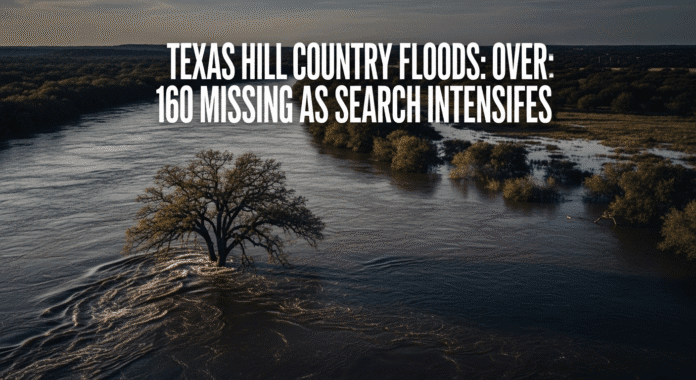Devastation, Delayed Warnings, and Demands for Change in a Tragic Texas Disaster
The Texas Hill Country floods of July 2025 have unleashed one of the deadliest crises in the region’s recent history. With more than 160 people still missing and over 100 lives lost – including heartbreaking casualties at Camp Mystic – communities are reeling as search and rescue operations continue under perilous conditions. The rapid surge of the Guadalupe River caught residents off-guard despite warnings, igniting a fierce debate about storm preparedness, emergency response, and the long-neglected flood warning systems.
A Disaster Unfolds in Kerr County
An Unprecedented Flash Flood
On July 3, 2025, relentless rains began to drench central Texas. By the early hours of July 4, meteorologists had escalated their alerts to a Flash Flood Emergency as the Guadalupe River surged. In an astonishing 45 minutes, the river crested 26 feet, submerging parts of Kerr County, including the towns of Kerrville, Hunt, and Ingram. Rainfall totals reached nearly 10 inches in some regions, overwhelming a community already vulnerable to flash flooding.
The Tragic Impact on Camp Mystic
Among the hardest-hit locations was Camp Mystic, a cherished summer camp situated along the Guadalupe River. In the darkness of the early morning, floodwaters tore through campgrounds and cabins. At least 27 campers and counselors lost their lives, and several individuals remain unaccounted for. Survivors recall moments of desperate bravery; one camp alum explained, “Counselors led the children in song and prayer as the water rose, trying to give hope in impossible circumstances.”
The Human Toll
In Kerr County alone, 87 fatalities—including 30 children—have been confirmed. Across Texas, the flood’s ravages have left 161 people missing, with rescue crews still sifting through flood-damaged terrain, debris, and wreckage. More than 850 people have been rescued so far as state, federal, and local agencies join forces in a race against time.
Search and Rescue Efforts Amid Treacherous Conditions
A Coordinated Response
A massive mobilization of emergency personnel marks the ongoing search efforts. Over 1,500 state workers, including Texas Game Wardens, FEMA teams, local law enforcement, and volunteer groups, have been deployed to navigate the flooded roads and treacherous riverbanks. Helicopters and drones have been integral in surveying the damaged landscapes.
Rescue crews face severe challenges: rapidly shifting water levels, unstable structures, and blocked roads complicate their mission. Amid these obstacles, public statements underscore the gravity of the situation. Kerr County Sheriff Larry Leitha remarked, “This will be a rough week. Primary search continues, and we remain hopeful every foot, every mile, every bend of the river holds one more life.”
Community and Federal Involvement
State leaders have not hesitated to intervene. Governor Greg Abbott declared a disaster for 21 counties, quickly requesting federal aid. During his visit, Abbott expressed the scale of the devastation, noting, “This disaster demands immediate action to address not only the emergency at hand but the long-standing gaps in our warning systems.” High-level officials from FEMA and Homeland Security have also joined efforts, offering both manpower and logistical support in this critical time.
The Debate Over Warning Systems and Preparedness
The Role of the National Weather Service
The tragedy has reopened discussions about the National Weather Service’s (NWS) capacity to issue timely warnings in regions with known flood risks. In the months leading up to the disaster, federal budget cuts resulted in significant staffing shortages at the NWS. The office serving Kerr County operated with a 23% vacancy rate, including a critical Warning Coordination Meteorologist position. Although the NWS managed to issue a Flash Flood Emergency in the early hours of July 4, many residents claim the warnings were either too brief or not effectively communicated.
Critics point to these staffing issues as a contributing factor. Tom Fahy, legislative director for the NWS Employees Organization, warned, “Continued cuts jeopardize lives. If we do not restore essential positions and proper infrastructure, tragic events like these will only become more frequent.”
Political Leadership and Proposed Reforms
Governor Abbott and Lieutenant Governor Dan Patrick have both called for immediate reforms. Lt. Gov. Patrick is pushing for state funding to install flood warning sirens along the Guadalupe River – a system that could provide crucial minutes for evacuation. Abbott has pledged that upcoming legislative sessions will scrutinize the failures of the existing warning systems and emergency response protocols. President Trump, visiting the scene, asserted, “Nobody expected it, nobody saw it,” a statement that has since drawn criticism from meteorologists and local officials alike.
Political and Social Reactions Across Texas
Leaders and Legislators Step In
In the wake of the disaster, political leaders have swiftly taken action. Governor Abbott’s declaration of disaster for 21 counties and the scheduling of a special legislative session illustrate the urgency to reform Texas’ flood preparedness. Local officials have also voiced their frustrations. Public pressure is mounting for accountability, as legislators now face calls to invest in improved infrastructure, enhanced forecasting capabilities, and better communication systems to prevent such tragedies in the future.
Community Solidarity and the Call for Accountability
In the midst of sorrow, Texans are uniting in resilience. Memorials, vigils, and community gatherings honoring the lost have surged across the state. Green ribbons and lights symbolize not only mourning but a collective determination to instigate change. Families, neighbors, and volunteers continue to support rescue efforts while demanding that lessons be learned from this calamity. The focus now shifts to ensuring that no family has to endure such loss again.
Historic Context: Comparing the 2025 Floods to Past Disasters
H3: Lessons from Hurricane Harvey and Earlier Floods
While Hurricane Harvey in 2017 inflicted massive urban damage and economic loss, the Hill Country floods of 2025 are notable for their rapid onset and disproportionate loss of life in rural areas. Past disasters in the Texas Hill Country – the floods of 1987, 1998, and the 2015 Blanco River event – underscored a persistent vulnerability. Yet, despite decades of previous calamities, rural regions still struggle with insufficient flood warning systems and emergency infrastructure.
The recent floods stand out as particularly deadly due to the speed at which the Guadalupe River surged. This event reinforces a troubling trend: as climate change intensifies severe weather, Texas must urgently upgrade its emergency preparedness protocols.
Looking Forward: Reform and Resilience
A Call to Action for a Safer Future
The Texas Hill Country floods of July 2025 provide a stark reminder of the interplay between nature’s fury and human preparedness. As families and rescue teams continue their heart-wrenching search for the missing, there is a clear mandate for change. The upcoming legislative session is expected to tackle long-standing issues: restoring the staffing and funding of the NWS, installing robust flood warning systems, and investing in community education and infrastructure improvements.
The community’s resilience and the unified call for accountability signal that this tragedy will not be forgotten. Texans now have an opportunity to forge a safer future by learning from these failures and demanding comprehensive reforms.
The devastating floods that rocked the Texas Hill Country have left scars that will endure for years to come. Yet, amid the loss and heartache, there is hope borne of a resolute call for change. As rescue efforts continue and families mourn, every Texan has a part to play in building a more resilient future. The time for reform is now. Stand with your community. Demand accountability from our leaders. And let us ensure that the tragedy of July 2025 becomes the turning point for a safer Texas.




